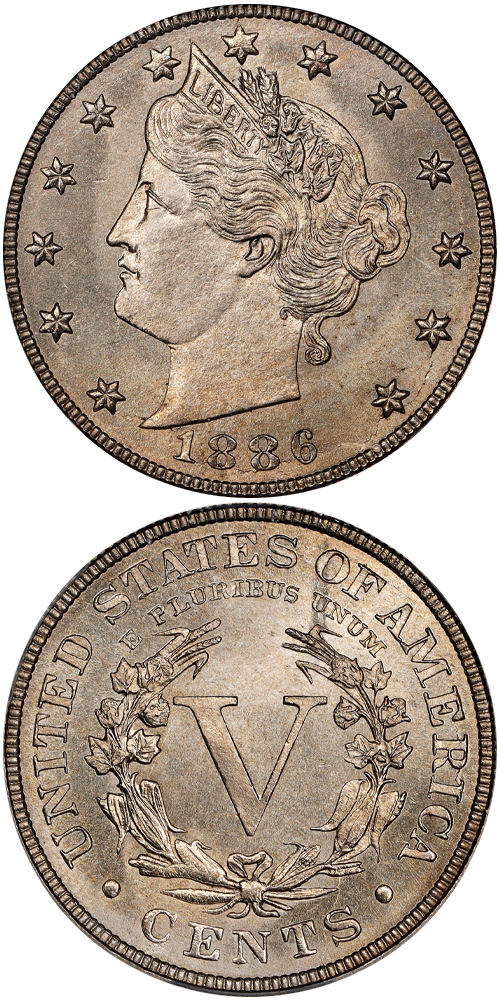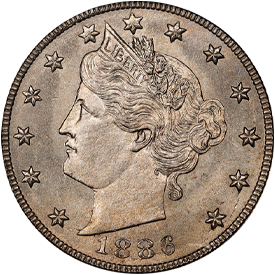Designed by: Charles E. Barber
Issue Dates: 1883-1912
Composition: 75% copper, 25% nickel
Diameter: 21.2 mm
Weight: 5.00 grams (77.16 grains)
Edge: Plain
Business Strike Mintage: 596,535,965
The Liberty or “V” nickel, a design by Charles E. Barber (later responsible for the dime, quarter and half in 1892) appeared in 1883. Drama surrounded both the first and “last” issue of the “V” nickel, for in 1913, five pieces were clandestinely struck by an “insider” at the Philadelphia mint, from dies prepared for 1913 in the event that the new design (featuring an Indian) was not yet authorized for use. These 1913 “V” nickels are among the most famous and valuable of all issues – even though they were “unofficial.”
Further Reading
Following the addition of CENTS later in 1883, nickels continued to be struck with this design officially through the year 1912. A number of scarce and rare issues exist within the series. 1885, with a business strike mintage of 1,476,490, is one of the most elusive, particularly in Uncirculated grade, for few were saved (collectors at the time preferred Proofs). 1886 is also scarce, as is 1894. While worn specimens of Liberty nickels exist in approximate proportion to the mintage figures, Uncirculated issues survived only as a matter of chance and are not available with the same consistency.
Abe Kosoff once told me that he spent several years looking for an Uncirculated 1891 Liberty nickel for a customer. His client insisted on an Uncirculated piece; a Proof wouldn't do. Finally, he located an example. Equipped with this knowledge I set about looking for 1891 Uncirculated nickels on my own, and while the issue seemed to be scarce, I was able to buy several over a period of years. This goes to show that what might be difficult for one person to locate might be acquired easily by another. Still, in terms of absolute supplies, an Uncirculated 1891 nickel is definitely rare, as are many other issues of the late nineteenth century. Most often seen today in Uncirculated grade are pieces from the late 1890s through 1912.
In the latter year nickels were struck at branch mints for the first time. The 1912-D nickel made its appearance as did the 1912-S, the latter with a restricted mintage of just 238,000. Immediately the 1912-S became scarce, and since the time of issue it has been considered to be a key date. Examples were struck from a bulged obverse die, with the result that the fields on a 1912-S nickel are slightly curved or bulged, quite unlike any other nickel in the series. This characteristic makes it easy to pinpoint when an S mintmark has been fraudulently added to a regular 1912 Philadelphia issue.
Diebreaks are often seen among early Liberty nickels, with issues of 1883 and 1884 being particularly plentiful in this regard. Uncirculated pieces of all dates are apt to show light striking on several obverse stars or at the lower part of the wreath on the reverse.







